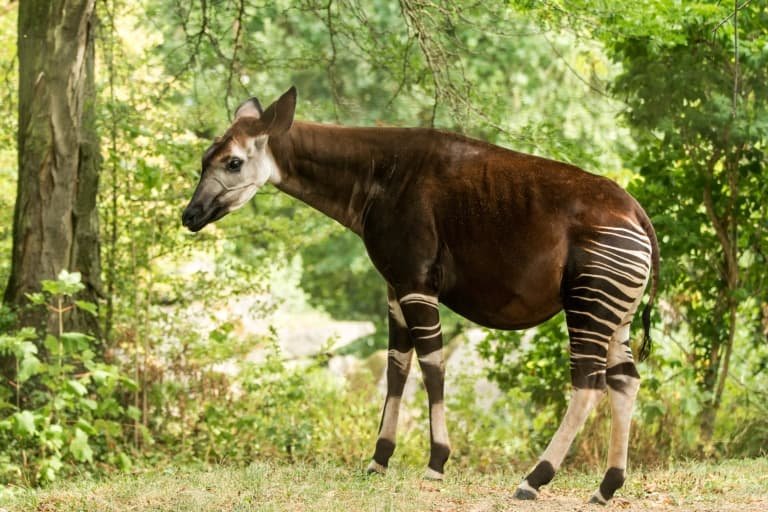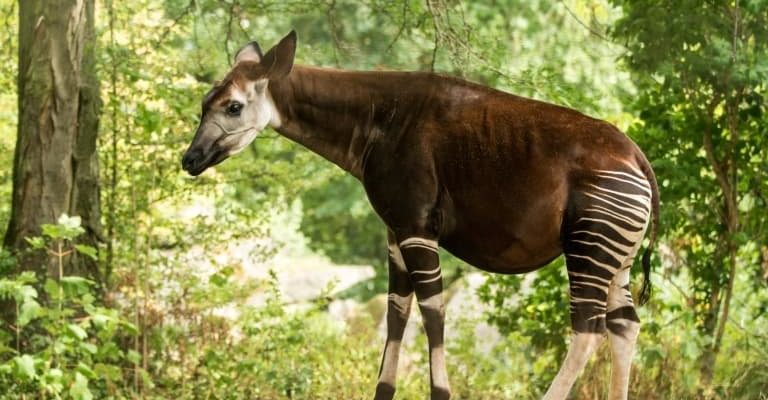
So, why should we be intrigued by okapis? Beyond their fascinating looks, they possess unique traits and behaviors that make them truly special. In this article, we’ll dive deep into the world of okapis and discover some amazing facts that not only highlight their unique characteristics but also their important role in the ecosystem. So, grab a warm drink, get comfortable, and let’s explore the top 10 fascinating facts about the okapi!
1. The Okapi Is a Close Relative of the Giraffe
When you look at an okapi, it might surprise you to learn that it’s more closely related to the giraffe than to any hoofed animal like a zebra. Both the okapi and giraffe belong to the same family, Giraffidae. This family diverged millions of years ago, but they share many similarities, such as their long necks and unique dental structure.
Here’s the thing: despite their resemblance to zebras, the okapi’s closest relative has a long neck and a spotted coat, not stripes. This close relation is a result of evolutionary adaptations that help both species thrive in their environments. While giraffes stretch their necks high to forage for leaves, the okapi has evolved to be an expert browser, finding delicious leaves and fruits in the dense understory of the jungle.
2. Habitat and Range
Okapis are found exclusively in the dense rainforests of the Democratic Republic of Congo. These lush forests are like a magical kingdom where okapis rule the shadows. Their habitat is rich in biodiversity, with towering trees, vines, and a variety of other plants that form a complex ecosystem.
However, the okapi’s range is quite limited. They thrive in a specific environment that provides the food and shelter they need to survive. This makes them particularly vulnerable to habitat loss due to logging, mining, and human encroachment. Hence, conservation efforts are vital to ensure these amazing creatures have a future in their native habitat.
3. Unique Appearance and Camouflage
One of the first things you’ll notice about an okapi is its striking looks. They have a long neck like a giraffe and a body with *bold, striped legs* that resemble those of a zebra. But why this unique styling? The stripes aren’t just for show. They serve as clever camouflage, helping the okapi blend seamlessly into the dappled light of the forest.
Imagine standing still in a sun-dappled forest—those stripes break up their outline, making it harder for predators to spot them. This ability to blend into their surroundings is crucial for their survival in a habitat where threats lurk nearby. Honestly, it’s like wearing the perfect outfit to hide at a party!
4. Solitary Lifestyle
Unlike many other animals that prefer the company of their peers, okapis are quite solitary. They roam the forest alone, coming together only during mating season. This lifestyle helps them maintain their territory and reduce competition for food, but it also makes spotting one in the wild a bit of a challenge.
Here’s the thing: being solitary doesn’t mean they’re shy. Okapis are quite vocal and communicate through a variety of sounds, including low whistles and grunts. These soft calls help them stay connected even when they are miles apart, creating a private network of communication that keeps their species connected in the vast forest.
5. Herbivorous Diet
Okapis are herbivores, which means they munch on leaves, fruits, and flowers. Their long, flexible tongues—similar to a giraffe’s—help them grasp and pull foliage down for a meal. You might even find them stripping leaves from tall trees, showcasing their unique feeding skills.
The okapi’s diet is diverse but specific. They tend to prefer certain plants that are abundant in their habitat. This selective eating helps maintain a balance in their ecosystem, as they play a role in seed dispersal when they consume fruits. By doing so, they help promote plant growth and ensure the health of their forest home.
6. Conservation Status
Sadly, the okapi is not currently thriving. They are listed as *endangered* on the IUCN Red List due to habitat loss, poaching, and civil unrest in their native region. Efforts are underway to conserve this incredible species, with organizations working to protect their habitats and raise awareness about their plight.
Conservation programs are also crucial for local communities to understand the value of protecting these majestic animals. By promoting ecotourism and sustainable practices, these programs aim to create a brighter future for both the okapi and the people living nearby.
7. Cultural Significance
The okapi holds a significant place in the cultural heritage of the Congolese people. Often referred to as the “forest giraffe” or “zebra giraffe,” this animal is a symbol of the lush tropical rainforests. Local communities have long revered the okapi for its beauty and uniqueness, incorporating it into folklore and cultural practices.
In recent years, as awareness about conservation grows, the okapi has also become a symbol for wildlife preservation efforts. It serves as a reminder of the delicate balance in the environment and the need to protect such wondrous creatures for future generations.
8. Unique Reproductive Behavior
When it comes to breeding, okapis have a fascinating reproductive process. A female okapi has a gestation period of about 15 months, which is quite long compared to other species. Once a baby, or calf, is born, it stays hidden in the underbrush for about two months while the mother forages for food.
This protective behavior allows the calf to grow strong before it starts to explore the world. Interestingly, when the calf is eventually introduced to the mother, the bond forms almost instantly, showcasing the strong maternal instincts that okapis possess. It’s heartwarming to think about how these gentle creatures nurture their young in the depths of the rainforest.
9. Discovering the Okapi
For a long time, the okapi remained a mystery to the outside world. It was only in the early 20th century that they were scientifically recognized. Think about it; a creature that looks like it belongs to an ancient storybook was entirely unknown to science until relatively recently!
The journey to discover the okapi is a testament to the wonders still left to explore in our world. As researchers study their habits and habitats further, they continue to unlock secrets about their behavior and ecology, showcasing just how much we still have to learn about our planet’s biodiversity.
10. Why the Okapi Matters to Us
Understanding the okapi and its role in the ecosystem is crucial for many reasons. They help maintain the health of their rainforest home, which is vital for global biodiversity and climate regulation. Rainforests are often referred to as “the lungs of the Earth,” and protecting animals like the okapi plays a part in keeping these ecosystems thriving.
Moreover, by conserving the okapi, we also protect countless other species and plants that share its habitat. Every creature, big or small, contributes to the delicate balance of nature. So, when we talk about preserving okapis, we’re really talking about safeguarding the health of our planet for everyone.
As we wrap up our journey through the amazing world of the okapi, it’s clear that this unique animal deserves our respect and protection. They hold a special place in the ecosystem and our hearts, reminding us of the beauty and mystery still found in nature. Let’s continue to learn more about these incredible creatures and contribute to their conservation. After all, the more we know, the better we can help.

